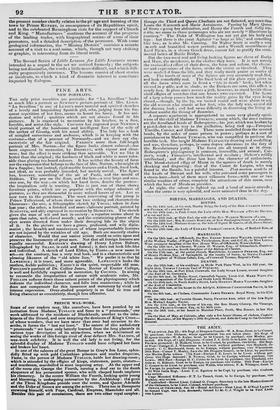FINE ARTS.
NEW PORTRAITS.
THE only print novelties are portraits ; for "La Sevellina" looks as much like a portrait as NEWTON'S picture-portrait of Mrs. Lister. " La Sevellina" is one of Lswis's most tasteful and spirited sketches of a lovely and languishing Spanish girl, who, judging from his fre- quent repetition of her face, seems to haunt his fancy. It has ani- mation and relief ; qualities which are not always found in his pictures. It is engraved in mezzotint by his brother, in a free, forcible, and artist-like style. COUsINS has engraved poor NEWTON s vivid portrait of the handsome and intelligent face of the wife of the author of Granby, with his usual ability. The lady has a look of mingled earnestness and archness, which is in keeping with the costume—that of a peasant of Normandy—and we dare say cha- racteristic of the fair original. PARRIS'S more than full-length portrait of Mrs. Norton—for the figure looks almost colossal—has been engraved in mezzotint, by BROMLEY, with vigour and clear- ness; but the effect is more striking than agreeable. Yet we like it better than the original ; the hardness of black and white is more toler- able than glaring tea-board colours. It has neither the beauty of form nor the expression that belongs to the face of Mrs. Norton, who might sit fora Sappho ; but instead, rigid marble features and a blank, fixed look, not ideal, as was probably intended, but merely unreal. The figure has, however, something of the air of Pasta, and the mould of Siddons. The pen on the floor, and the lyre—a very large and mas- sive one, by the way—on which her hand rests, denote the poetess : the inspiration only is wanting. This is just one of those showy furniture prints, which are as popular with the vulgar admirers of pictures, Its they are distasteful to more refined lovers of art. Let us now turn to the gentlemen. The most interesting of the group is Prince Tulleyrand, of whom there are two striking and characteristic likenesses : the one, a lithographic. sketch by Voest, taken in June last year ; the other, a finished and more elaborate portrait, painted by SCHEFFER, and ably engraved in mezzotint by HODGETTS. The sketch gives the man of wit and tact in society: a repartee seems about to open that calm, well-closed mouth ; and the scrutinizing glance of the eyes seems directed from under their drooping lids to the object of it. In the picture we have a grave, profound, and wily diplo- matist ; the breadth and massiveness of whose imperturbable features are not injured by the wrinkles of old age. Both are masterly studies of character. Would that our native artists could so seize upon and preserve the lineaments of great men. Not that all foreign limners are equally successful. KRIEGER'S drawing of Henry Lytton Bulwer, lithographed by Simile, is cold and formal ; it does not look life-like and individual. A sketch of Lord Eldon, by EDDIS—a new name in art—on the contrary, has a very real look, and is a characteristic and Lpleasing likeness of the "old white lion." We prefer it to that by AWRENCE; it is truer, and more agreeable. LAWRENCE'S looks the restless, feeble politician ; EDDIS'S is the quiet, respectable old man. PHILLIPS'S portrait of Dr. Collier Jones, Rector of Exeter College, is well and faithfully engraved in mezzotint, by Covsuess. In aiming to reconcile the irregularities of nature with academic rules, Mr. PHILLIPS softens down those salient points of the physiognomy which indicate the individual character, and falls into mannerism ; while be does not compensate for this tameness and monotony by vivid and intense expression. Over-studied propriety is as fatal to true and living character as eccentricity, though less offensive.


























 Previous page
Previous page